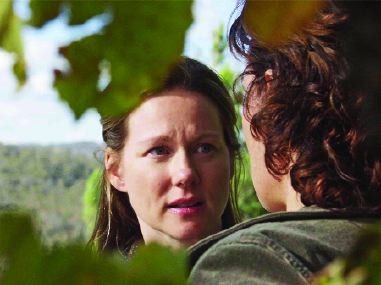Fishing for answers

Alfred Hitchcock said that the literary form that most resembles a movie is not the novel but the short story, since it is designed to be digested in one sitting. But the dilemma for moviemakers who adapt short stories is that they almost always need to beef up or expand the story so it can fill 90 minutes or more. (Novels, on the other hand, usually need to be trimmed or compressed for film.)
The Australian film Jindabyne is based on the story “So Much Water So Close to Home,” by the American writer Raymond Carver, who died in 1988 at the age of 50. The story was also employed in Robert Altman’s 1993 film Short Cuts, which used various Carver stories to flesh out an Altmanesque view of Los Angeles. Director Ray Lawrence (Lantana) and screenwriter Beatrix Christian are more aggressive adapters than Altman. They add many elements and alter others, starting with shifting the setting from the Pacific Northwest to southeastern Australia.
Jindabyne (the title is an Aboriginal word for valley) features a psychological battle between Claire (Laura Linney), an American transplanted Down Under, and her husband, Stewart (Gabriel Byrne), an Irish garage owner who once enjoyed a glamorous life as a racecar driver. They have a son, Tom (Sean Rees-Wemyss), who seems to be their pride and joy, but their marriage carries a lot of baggage, including the fact that Claire, while suffering postpartum depression, left the family for 18 months just after Tom was born. Now she is (unintentionally) pregnant again and worries that having a second child may cause the cycle to start once more.
Once a year Stewart and his buddies take a weekend fishing trip to a river far away from home. They fish to their hearts’ content, sleep under the stars, drink to excess and swap the sort of tales that men swap when they are alone in the wilderness. Once they arrive at their idyllic spot, however, Stewart discovers a grisly sight: the dead body of a young woman floating half-nude in the river, a huge knife wound in her chest. He is shocked, as are the others, but instead of taking the long walk back to the main road to report their find (they are out of cell-phone range), they decide to let the body float while they continue their weekend. (“There’s nothing we can do for her. She’s already dead,” is their rationale.)
When the men return home and family and friends learn what transpired, all hell breaks loose. Not only do the local media have a field day, portraying the four fishermen as insensitive yokels, but the incident forces Claire to reexamine the man she has married and in so doing reevaluate her own life.
The struggle between Claire (“How could you have done that?”) and Stewart (“What did I do that was so wrong?”) is also at the heart of the Carver story, which burrows into Claire’s mind to examine her feelings about the differences between women (“She needed help!”) and men (“She was dead!”), a familiar Carver theme. But Jindabyne guts that story for the sake of adding subplots and new characters, some of which work better than others.
Jindabyne, it turns out, was a real town that was intentionally flooded to make way for a large dam project, and to this day anglers hook curious items when they fish. This overt metaphor suggests that the deepest, darkest secrets of the town tend to surface no matter how much the residents try to keep them submerged. To enhance the theme, the filmmakers make the girl found in the river an Aboriginal, thereby adding the theme of racism (“Would you have left a white woman there?”) to that of sexism (“What if it had been a man?”). Plus, the film introduces the killer himself, an aging white man who has supposedly killed before and will probably kill again.
The movie layers a series of stories around the tale’s ethical core, each one moving further away from the basic story. Those circles closest to the struggle between Claire and Stewart work best, including Claire’s ongoing difficulties with her demanding mother-in-law, who pinch-hit for Claire during her disappearance. It’s not that the film is unfaithful to Carver’s scrutiny of a fragile marriage, but that it feels a bit crowded in places and struggles to the finish line weighed down with too much plot.
But when it feels like the film might collapse, Linney is there to rally the troops. Fast becoming one of this country’s great film stars, she is able to do more with a hard stare or a sad smile than any actress this side of Meryl Streep. Her presence, along with a fine supporting ensemble and some stirring cinematography by David Williamson, keeps Jindabyne on track.




